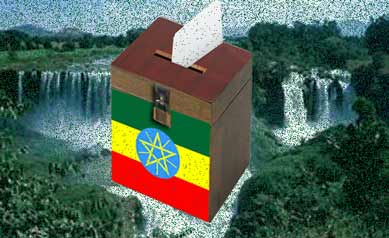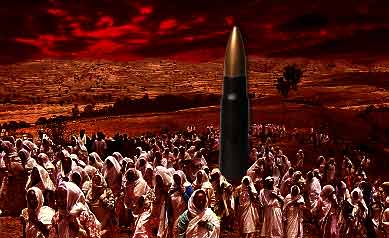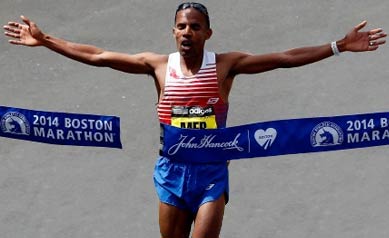Election Season: Ethiopia Hoy!

Probably the best thing that is happening in the 2015 Ethiopian election is the absence of European Union (EU) observers. The last time EU sent observers in 2005, “Anna Gomez the European parliamentarian seemed to be running for a seat in the Ethiopian parliament.”
So far, the African Union (AU) has deployed almost sixty election observers under the leadership of Mr. Pohamba, the former Namibian president. But some opposition member are not happy; they remember the EU participation with nostalgia and are lamenting over their absence in this election. The VoA quoted Semayawi Party spokesman who said, “We don’t think the [African Union] is an international observer, it’s a legitimacy of dictatorship.“.
Though reports indicate that the EU has stated it was not invited, a sources close to EPRDF told Gedab News that “the European Union has put conditions on the government to participate in the monitoring.” Another Anna Gomes syndrome cannot be ruled out because usually, “the EU presents recommendations which they treat as orders that should be obeyed, and some stubborn African leaders don’t listen.”
The 2005 election was marred by violence; close to 200 civilians and seven policemen were killed in the unrest. For a few days, Addis Ababa was immersed in what looked more like an urban warfare spree than an election season. Despite that, the opposition spoiled it for themselves when they decided on wining all or nothing. Instead of taking the one-third of the total seats they won, they rejected the results and denied Ethiopia a faster learning curve in the election process.
In 2010, the opposition was too crippled to run a successful campaign and the panicked EPRDF, which hadn’t recovered from the shock of the 2005 turmoil, campaigned so hard it ended up winning 99.6% of the seats, .6% more than the typical African margin of 99%. That didn’t look good on Ethiopia and it will certainly not look good if it is repeated in 2015.
In order for an Ethiopian election to be promising, it should break the embarrassing 99% win that is all too common in the elections of the region. Anywhere around 75% would be ideal, though at this moment, to expect a less than 85% win for the EPRDF is unrealistic.
The opposition is hardly as widespread and as organized as the EPRDF. Therefore, it is not the winning, but the size of the win that will indicate how far Ethiopia has moved towards an equitable share of political power. For a party aspiring to promote democracy, to control 545 seats of the 547 seat parliament is not admirable. There was only one lone opposition deputy, Girma Seifu, who could crush the inauguration party of the EPRDF controlled parliament.
In a 2010 interview, the late Prime Minister Meles Zenawi told awate.com’s Saleh Johar that he will leave office in 2015 together with the EPRDF old guards. He said, “And that would be my departure and the team that departs with me would be the last one. That is why everybody has to depart between the beginning of this term and the end of this term [2010-2015].” He died two years later and didn’t survive the term.
But his promise has been kept as new faces replaced most of the old guard in senior government positions–the replacement was even hastened after his departure and Ethiopian government officials are steadily becoming younger and more diverse. At the same time, the country is registering a steady double digit economic growth and expanding its middle class. In addition, the EPRDF has about succeeded in changing the negative perception and transforming the long held image of a famished country, with impressive results. A reasonable win by the opposition would be considered a win for Ethiopian democracy and will enhance the efforts of re-positioning of the country.
Who stands a chance?
Almost sixty parties, many of them organized along ethnic lines, are running for the 547 federal legislative seats. The main contenders include the Ethiopian Federal Democratic Unity Forum; a coalition popularly known as Medrek ; the Semayawi Party; and Unity For Democracy And Justice.
The incumbent EPRDF boasts of a large base estimated at around 6.5 million card-holding members.
The show of force is visible in the capital city which influences election results in most of the country. However, the EPRDF campaign has been stronger and its rallies attracted far more people compared to the opposition rallies. The four party coalition of EPRDF which has been in power since it defeated the Derg regime in 1991, is expected to win in all the 9 regions that make the Federal Republic of Ethiopia, and seems secure in its leading position, at least for the coming term.
Semayawi, the new darling of the city which was formed three years ago has a less visible presence outside urban areas, and it stands a good chance of winning significant seats in Addis Ababa due to its relatively better organized campaign, and its diverse and young supporters. It is mainly running on an anti ethnic federalism ticket. According to an observer, “the ticket might appeal to the multi-ethnic urban centers, but elsewhere in the country, ethnic federalism is considered an empowering of minorities.” Overall, the party is expected to win a relatively smaller number of seats from the 135 seats it aspires to acquire.
Another serious contender is Medrek, a party which is expected to gain considerable votes in the Oromia region, and through the influence of its allies, a small share of the Tigray votes.
As expected, in the last few days, the opposition has been claiming to have been denied breathing space by the EPRDF; Semayawi claims that over half of its registered 400 candidates were rejected, but the electoral board explains that “the rejected had multiple membership in parties and that is against the board’s regulation.”
It is likely the complaints will increase after the announcement of the results because none of the opposition is poised to secure enough seats to form a government. At best, they are expected to be junior partners in some regional governments, though lesser in the federal parliament.
Real Life
Behind the forest of shiny glass and concrete buildings that have been popping up in all Ethiopian cities for the last decade, fighting poverty still remains the main challenge facing Ethiopia. Inflation is pushing more people to destitution, and the glamour of the cities is attracting huge numbers of people from the countryside. However, the economy is not expanding enough to absorb the new workforce entering the market every year . Even though the country has registered impressive growth rates, a big chunk of the 85 million Ethiopians lives below the UN poverty line..
Stability
Although not popular, the Ethiopian anti terrorism law has helped the EPRDF stabilize the country and at the same time consolidate its power. But the law has made Ethiopia the target of strong criticisms by rights organizations that accuse the country for having a thin skin in dealing with dissenters, and for human rights violations. The unpopular anti terrorism law is known to be repressive, where ever it is proclaimed, including in the USA which piloted the law after 911. The collapse of security in Somalia and terrorist attacks in its cities gave Ethiopia the excuse to adopt the law. However, it seems that the law, once enacted, has no chance of being repealed before it inflicts enough damage on the freedom of the citizens and the image of the country.



Awate Forum